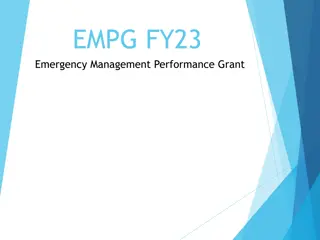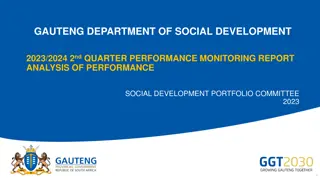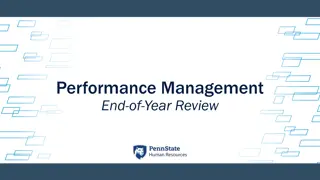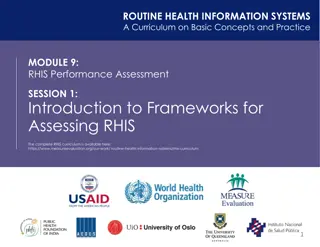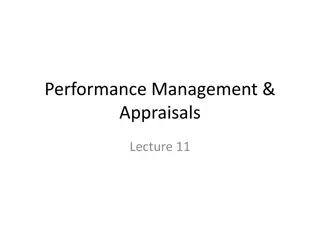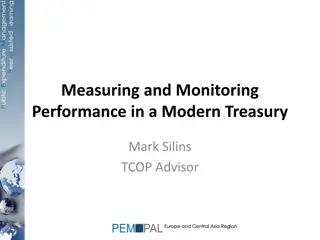
Enhancing Healthcare Performance Management for Optimal Organizational Success
Performance management in healthcare, led by Dr. Mohammed Alahmed, focuses on ensuring goals are met efficiently. It promotes employee effectiveness, supports better patient outcomes, and translates organizational vision into measurable goals for success. Implementing a strategic performance management system can lead to improved service delivery, resource allocation, and overall organizational effectiveness.
Download Presentation

Please find below an Image/Link to download the presentation.
The content on the website is provided AS IS for your information and personal use only. It may not be sold, licensed, or shared on other websites without obtaining consent from the author. If you encounter any issues during the download, it is possible that the publisher has removed the file from their server.
You are allowed to download the files provided on this website for personal or commercial use, subject to the condition that they are used lawfully. All files are the property of their respective owners.
The content on the website is provided AS IS for your information and personal use only. It may not be sold, licensed, or shared on other websites without obtaining consent from the author.
E N D
Presentation Transcript
Performance Management in Healthcare Dr. Mohammed Alahmed Dr. Mohammed Alahmed http://fac.ksu.edu.sa/alahmed alahmed@ksu.edu.sa 1
Introduction Performance management (PM) includes activities which ensure that goals are consistently being met in an effective and efficient manner. Performance management can focus on the performance of an organization, a department, employee, or even the processes to build a product or service, as well as many other areas. Dr. Mohammed Alahmed 2
Introduction The fundamental goal of performance management is to promote and improve employee effectiveness. It is a continuous process where managers and employees work together to plan, monitor and review an employee's work objectives or goals and his or her overall contribution to the organization. Performance management in health care is not only aiming at the systematic generation and control of an organization s economic value but also at the optimization of the efficiency and effectiveness of service delivery. Dr. Mohammed Alahmed 3
Introduction Performance management Performance management supports better patient outcomes, and provides the knowledge to run more effective organizations. For example, integrating your overall healthcare strategy through scorecards or strategy maps with the appropriate underlying reports lets clinicians understand what drives better care, and helps administrators see what drives the bottom line.. The use of performance measurement information to effect positive change in organizational culture, systems and processes, by helping to set agreed-upon performance goals, allocating and prioritizing resources, informing managers to either confirm or change current policy or program directions to meet those goals, and sharing results of performance in pursuing those goals. Dr. Mohammed Alahmed 4
Performance Management System Goals Translate organization vision into clear measurable outcomes that define success, and that are shared throughout the organization and with customers and stakeholders; Provide a tool for assessing, managing, and improving the overall health and success of business systems; Continue to shift from prescriptive, audit- and compliance- based oversight to an ongoing, forward-looking strategic partnership involving agency headquarters and field components; Include measures of quality, cost, speed, customer service, and employee alignment, motivation, and skills to provide an in-depth, predictive performance management system; and Replace existing assessment models with a consistent approach to performance management. Dr. Mohammed Alahmed 5
Performance Management Tools When you are developing a performance measurement system, you should consider a conceptual reference model: 1. The Balanced Scorecard in Healthcare Organizations 2. Logic Models in Public Health Program Management. Dr. Mohammed Alahmed 6
THE BALANCED SCORECARD IN HEALTHCARE ORGANIZATIONS Dr. Mohammed Alahmed 7
Introduction The Balanced Scorecard (BSC) is a strategic planning and management tool that is used extensively in business and industry, government, and nonprofit organizations worldwide to align business activities to the vision and strategy of the organization, improve internal and external communications, and monitor organization performance against strategic goals. Dr. Mohammed Alahmed 8
Introduction The BSC was developed in the early 1990s by two guys at the Harvard Business School: Robert Kaplan and David Norton. A Measurement System? Dr. Mohammed Alahmed A Management System? A Management Philosophy? 9
Balanced Scorecard Original Definition A multi-dimensional framework for describing, implementing and managing strategy at all levels of an enterprise by linking objectives, initiatives, and measures to an organization s strategy. Dr. Mohammed Alahmed Kaplan & Norton, 1996 10
Which dimensions should we measure? Dr. Mohammed Alahmed 11
The Four Perspectives of the Balanced Scorecard All indicators related to financial goals Improving relations with customers, improving organization image Financial Customer Dr. Mohammed Alahmed Internal Process Learning/ Growth Optimizing internal process and improving performance Education of personal, growth strategies 12
Why have a Balanced Scorecard? Health sector is complex, has many components Need an efficient way to assess multiple objectives Overloaded with different types of reports Stakeholders demand vigilance Poor measurement can lead to crisis Dr. Mohammed Alahmed 13
Balanced Scorecard in Healthcare In 1999, Wachtel, Hartford, and Hughes (1999) examined whether BSC method is suitable for the management of medical organizations. Application of BSC method in healthcare organizations is also described by: Stevard and Bestor (2000, s. 75 82) - Applying a Balanced Scorecard to Health Care Organizations, Bisbe a Barrub s (2012, s. 919-927) The Balanced Scorecard as a Management Tool for Assessing and Monitoring Strategy Implementation in Health Care Organizations, Dr. Mohammed Alahmed 14
Balanced Scorecard in Healthcare Chow, Gaunulin, Haddad a Williamson (1998) - The Balanced Scorecard: A Potent Tool for Energizing and Focusing Healthcare Organization Management, Swayne, Duncan a Ginter (2008, s. 378-379) - Strategic management of health care organizations, Fortenberry (2010, s. 248-259) in monography Health care marketing: tools and techniques, Lin et al. (2013, s. 1917-1924), in article: Integrating hierarchical balanced scorecard with fuzzy linguistic for evaluating operating room performance in hospitals, apply BSC into specific environment such as hospitals are. Dr. Mohammed Alahmed 15
Balanced Scorecard in Healthcare BSC application into management of healthcare organizations can be defined as follow: How patients perceive an organization? (Customer perspective). What is financial situations? (Financial Perspectives) What can we do to improve level of services? (Perspective of learning and growth) What do we want to be the best in? (Perspective of internal business processes) Dr. Mohammed Alahmed 16
Balanced Scorecard in Healthcare Duke University Hospital explained these four perspectives in healthcare organizations as follow (Jones and Filip, 2000): Customer perspective: Deliver high quality innovative care while respecting needs of the patient. Financial perspective: Deliver strong and consistent financial performance in the eyes of payers and the board of trustees. Learning perspective: To be recognized as a leader in developing skills and performance of employees. Business perspective: To be recognized as the premier provider of health care services in our region/market Dr. Mohammed Alahmed 17
Balanced Scorecard in Healthcare Potential benefits for the successful implementation of the BSC in the healthcare organizations: It aligns the organization trend a more market oriented, customer-focused strategy, It facilitates, monitors, and assesses the implementation of the strategy, It provides a communication and collaboration mechanism, It assigns accountability for performance at all levels of the organization, It provides continual feedback on the strategy and promotes adjustments to marketplace and regulatory changes Dr. Mohammed Alahmed 18
Implementing a Balanced Scorecard Collaborative Efforts - Implementing the BSC agency-wide will provide: 1. a common methodology and coordinated framework for all agency performance measurement efforts; 2. a common language for agency managers; 3. a common basis for understanding measurement results; and 4. an integrated picture of the agency overall. Dr. Mohammed Alahmed 19
Implementing a Balanced Scorecard Pathway to Success 1. Make a commitment at all levels especially at the top level 2. Develop organizational goals 3. Offer training in improvement techniques 4. Establish a reward and recognition system to foster performance improvements 5. Break down organizational barriers. 6. Coordinate Headquarters and Field Office Responsibilities Dr. Mohammed Alahmed 20
Implementation steps of BSC Dr. Mohammed Alahmed 21
Elements of the Balanced Scorecard Mission and vision Perspectives Financial Customer Internal business process Learning and growing Linking measures to strategy Structure and strategy Strategic alignment top to bottom Targets, resources, initiatives, and budgets Feedback and the strategic learning process Dr. Mohammed Alahmed 22
Example: Brigham and Womens / Faulkner Hospital Strategy Map (2009) Dr. Mohammed Alahmed 23
Brigham and Womens / Faulkner Hospitals Some key learnings: Having automated performance reporting software facilitates monitoring and analysis of results at all levels of the system as well as more rapid rollout of the Balanced Scorecard. Real time reporting, particularly for operational measures, is seen as an important goal for more rapid and timely decision-making. This is a good example of where a Balanced Scorecard in the health sector has been cascaded to individuals it shows it can be done for medical staff as well as management, something that some organizations see as too hard Dr. Mohammed Alahmed 24
What is a logic model ? Whether your agency s programs or initiatives are large or small, simple or complex, short-term or long-term, they probably share some common elements. A logic model simply depicts the relationships among all these different elements in some logical order in a way that can be readily understood by someone who was not involved in the program planning or design. Dr. Mohammed Alahmed 26
What is a logic model ? A logic model visually links program inputs and activities to program outputs and outcomes, and shows the basic (logic) for these expectations. A graphic depiction of the relationship between the key elements of a program or initiative Dr. Mohammed Alahmed 27
How are logic models used? Logic models can be used in many ways, including: For program design/planning For strategic planning To test initial assumptions For ongoing monitoring of program implementation To evaluate long-term results To communicate with and establish buy-in from stakeholders To negotiate with partners, funders, and other stakeholders Dr. Mohammed Alahmed 28
What are the benefits of using a logic model approach? A logic model s visual depiction of how a program is expected to unfold and/or how an organization is expected to reach its goals offers several benefits. It allows for quick and efficient testing of assumptions, providing opportunities for feedback. It yields insights into potential indicators and measures of progress for the most important outcomes Dr. Mohammed Alahmed 29
Logic Model Components Although there are many different logic model templates and formats available, most cover the following components: Inputs any resources needed in order to implement the activities (e.g., funding, staff time, community partnerships, technology, data, etc.) Outputs what you will do, and whom you intend to reach. Our approach further divides outputs into: Activities the specific steps, work plans, or program areas you (and any partners) expect to undertake with the resources listed above; and Participation the intended audience you are trying to reach with your activities. Dr. Mohammed Alahmed 30
Logic Model Components Outcomes the results you expect to achieve because of your inputs and outputs. Outcomes can be subdivided into time frames, depending on how long they may take to achieve and how long the project is expected to last overall (i.e., the intensity and duration of the project). For example, short-term outcomes are generally those expected to be achieved in the first year; intermediate outcomes may take up to 2 to 5 years; and long-term outcomes may take longer than 5 years. Dr. Mohammed Alahmed 31
Logic Model Components Impact a vision for the ultimate effect that all the inputs, outputs, and outcomes, taken together, could achieve in an ideal future. Generally, impact isn t as measurable and concrete as the other components; it might include statements such as Improved health outcomes for Georgians or Equitable access to health care for all residents. Like a vision statement, impact is intended to be aspirational and inspirational. Dr. Mohammed Alahmed 32
Logic Model Components Resources The inputs dedicated to or consumed by the program Outputs The measurable products of a program s activities Outcomes The benefits to clients, communities, systems, or organizations Activities The actions that the program takes to achieve desired outcomes Dr. Mohammed Alahmed 33 How? Why? So what?
Logic Models in Public Health Program Management Context for Logic Models: Quality improvement in public health is the use of a process, such as Plan-Do-Study-Act, which is focused on activities that are responsive to community needs and improving population health. Refers to a continuous and ongoing effort to achieve measureable improvements in the efficiency, effectiveness, performance, accountability, outcomes, and other indicators of quality service. Dr. Mohammed Alahmed 34
Example Logic Model Resources Dental Clinic Coordinator Community Health Director Staff dentist Staff pediatrician Medical providers Money for supplies Activities Training Develop curriculum Two one-hour didactic trainings to medical providers in oral health assessment One-on-one training to medical providers on oral health Outputs Outcomes Training # of two-hour trainings held # of one-on-one trainings held # of medical providers trained Medical providers demonstrate accurate oral health assessment, education and prevention activities Dr. Mohammed Alahmed More children receive high-quality oral health assessment, education and prevention activities during well-child visits Parents/children are more knowledgeable about oral health and caring for children s teeth Outreach # of parents/children receiving packets Outreach Order dental supplies for packets Make up packets Distribute to parents at end of each visit Reduced incidence of caries in children at the community health center 35
Benefits of Logic Models 1. Integrates planning, implementation, performance measurement and evaluation 2. Prevents mismatches between activities and effects 3. Builds program clarity from the process 4. Keeps staff, managers, and partners focused on outcomes 5. Helps planners prioritize most effective activities for directing resources 6. Uses evidence-based models and practice wisdom to design and refine a program 7. Reveals data needs and framework for analyzing data Dr. Mohammed Alahmed 36
Limitations and Pitfalls of Logic Models 1. Logic models make the program theory clear not true 2. They take time to complete 3. Without data collection, their utility is limited 4. They strike fear in the hearts of many 5. Pursuit of perfection can impede utility 6. The notion that evaluation is being done to me, rather than with me Dr. Mohammed Alahmed 37
The Value of Logic Models What gets measured gets done If you don t measure results, you can t tell success from failure If you can t see success, you can t reward it Dr. Mohammed Alahmed If you can t reward success, you re probably rewarding failure If you can t see success, you can t learn from it If you can t recognize failure, you can t correct it 38 If you can demonstrate results, you can win public support
Creating a Logic Model How? No single way, flexible Forward logic driven by But Why? or If- Then thinking Starting from the condition or problem end Reverse logic driven by But How? Starting from the vision end Who? Depends When? Varies Dr. Mohammed Alahmed 39
Example of logic models Dr. Mohammed Alahmed 41
Smoke-free environments Dr. Mohammed Alahmed 42




